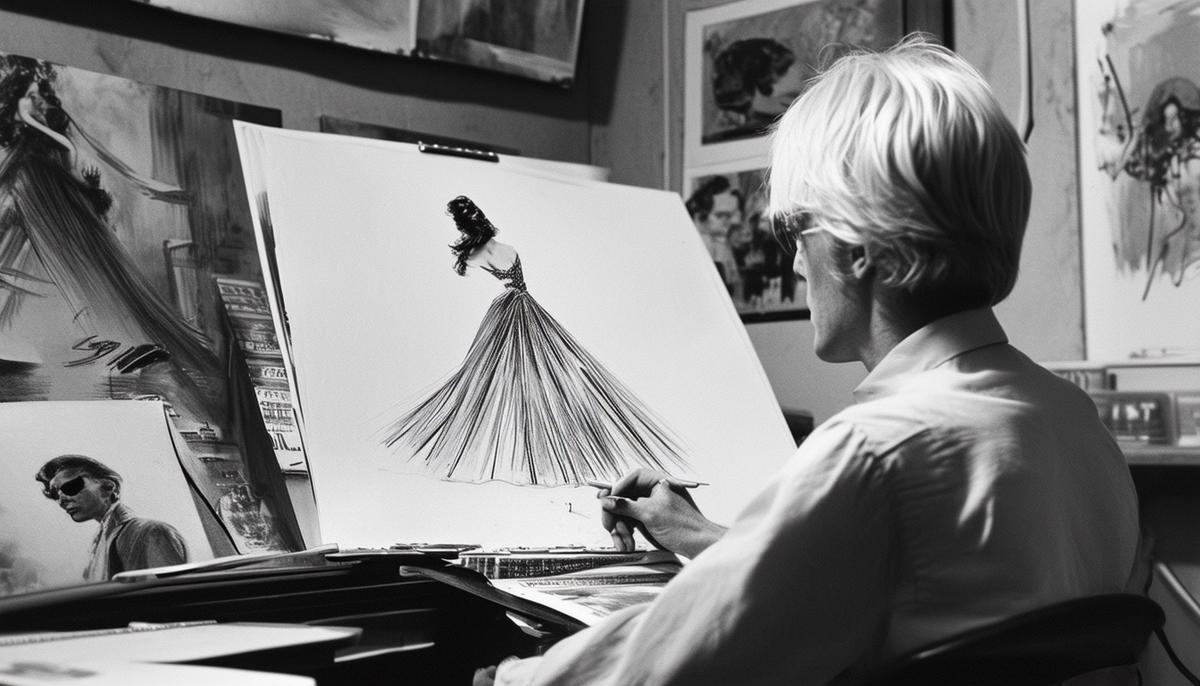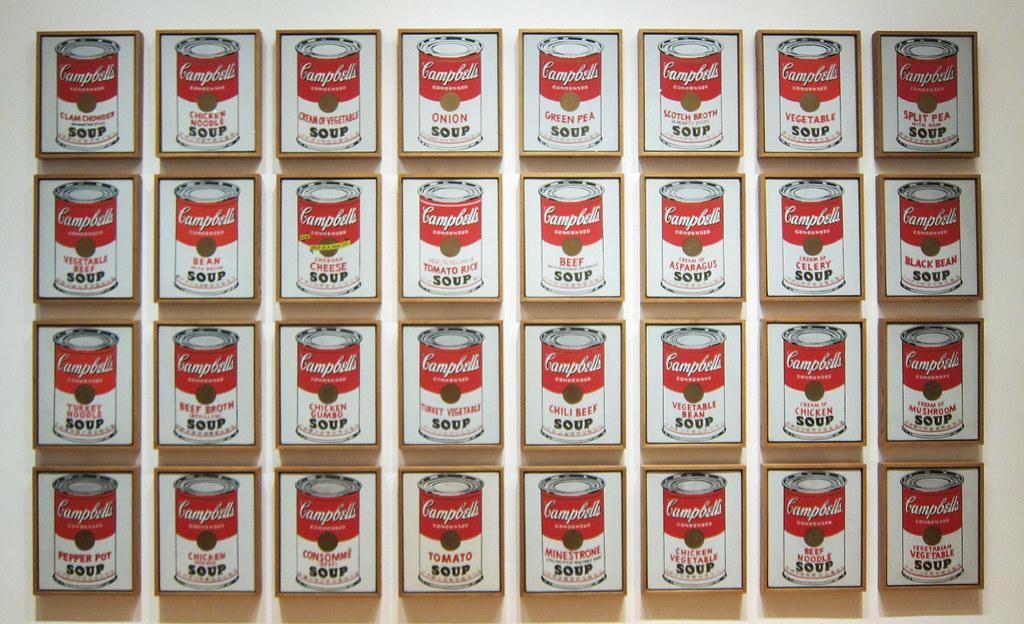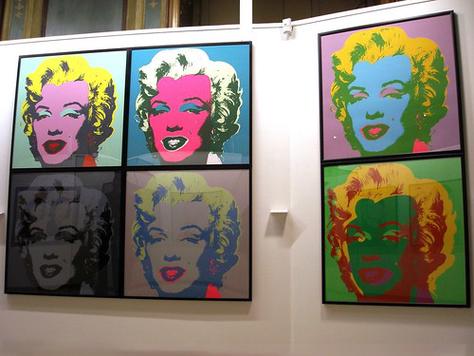Commercial Illustration Roots
Andy Warhol's early career in commercial illustration established a precedent that persisted throughout his oeuvre. In the 1950s, Warhol made a mark as an illustrator for prestigious publications such as Vogue and Harper's Bazaar. His unique way of perceiving and illustrating the world depicted ordinary objects with an unfamiliar charm—an outlook that profoundly influenced his pop art phase.
Warhol's blotted-line technique, developed during his studies at the Carnegie Institute of Technology, was a significant innovation. This method involved applying ink to non-absorbent paper and pressing a second sheet onto it to absorb some of the ink, resulting in a dotted-line appearance. This technique allowed for both unparalleled exactness in replication and an element of unpredictability, foreshadowing the serial themes in his later work.
As Warhol transitioned into the 1960s, his shift from whimsical illustrations to poignant pop culture pieces about consumerism highlighted his thematic evolution. He applied his commercial savvy to conjure art that commented on—and often critiqued—mass culture and its idiosyncrasies.
The threads connecting Warhol's commercial illustration roots and monumental pop art are unquestionable. His early professional endeavours anchor the depth of perspective that defined his artistic ethos right into the cultural revolution he came to symbolize.

Development of Repetition
As Warhol's career expanded into the 1960s, his fascination with repetition became increasingly pronounced. The concept of repetition can be traced back to his days as a commercial illustrator, where mass-production and dissemination of the same image are crucial. These methods transitioned into a dominant theme in his artistic canon.
Warhol's use of silkscreen printing after the early 1960s allowed him to replicate images like a production line—a nod to industrial practices and the growing prevalence of consumer culture. Replication abetted the management of demand for his works and manifested his conceptual inquiries into ubiquity and uniformity in mass culture.
Warhol's seminal 32 Campbell's Soup Cans (1962) captures an essence of commonality paired with the personal—a subtext suggesting that while goods could be uniform, individual experiences of them could vary. This intrigue into variance within homogeneity was provocative, resonating with how consumers engaged with identical products daily.
In the Shadow series (1978-1979), Warhol delved into the philosophical substrata of repetition, using abstract images to explore nuances of form and color while underscoring how subtle alterations affect perception. Despite representing shadows, each portrayal introduced layers of variance, emphasizing that no two perceptions or experiences are genuinely identical.
Repetition, initially curated from Warhol's commercial molds, was teased out through his career to engage deeper societal discourses on identity, consumerism, and cultural monotony. His art underscores a relentless intertextuality between commercial methodologies and fine art—an evolution that marked Warhol as a pioneer who reshaped contemporary understanding of art's intersections with daily life.

Influence of Pop Culture
Warhol's infatuation with fame and his understanding of celebrity culture were central to his artistic manifestation. His early illustrations for magazines, featuring celebrity portraits, forecasted his later plunge into the celeb-centric interactions of pop art.
The transition to paintings of idols like Marilyn Monroe and Elvis Presley signaled a deep delve into the cult of personality that defined American culture during the 1960s. Warhol's choice of subjects—glamorous, tragic, admired, and often consumed by their public personas—were as much about the individual icons as about the broader commentary on the consequences of fame and the commercial machinery supporting it.
Warhol's iconic Gold Marilyn Monroe juxtaposes a celebrity's face with a golden background, immortalizing and sanctifying Monroe in the public's gaze. Through such artwork, Warhol exposes and explores the commodification of celebrity, where faces are duplicated repeatedly, like products coming off a production line.
The charm of these creations sprung from the slick, seductive visuals of his fashion illustrations. The simplicity of the images made them instantly recognizable—a mechanism lifted from his commercial work, speaking to mass consumption and broader accessibility.
Warhol's exploration of pop culture not only critiqued but significantly altered the engagement with celebrity culture in visual art. The creator became a curator of cultural symbols, reflected and magnified for societal cross-examination. This convergent approach echoed his earlier commercial assignments, now empowered with richer layers of cultural introspection.

Early Techniques and Materials
Before diving wholly into pop art, Andy Warhol's creative tapestry was richly embroidered with an array of preliminary techniques and materials—a repertoire budding under his commercial endeavors. These initial artistic methods had a critical impact on his famous silkscreen endeavors and outline a continuum in Warhol's transformation from illustrator to pop art colossus.
During this period of evolution, ink and watercolor emerged as pivotal materials in Warhol's creation cycle. His illustrations embraced the fluidity of watercolor alongside the definitive starkness of ink. This combination facilitated a distinctive finish that poised between whimsical charm and pointed acuity, a duality that became a recurring motif in his subsequent works.
The frugality of watercolors permitted Warhol to experiment with varying saturation levels, which later translated into his bold color palettes in printmaking. The sharper lines created with ink benefitted his adherence to simplistic yet striking design—traits coveted in the consumer-driven visuals of pop art.
Warhol's blotted-line technique endorsed his concepts of reproduction and seriality. Through this exercise—where ink is partially applied then 'blotted', transferring some image aspects but leaving others to chance—Warhol honored the mechanical process with a personal touch. It intertwined accident with intent, offering both uniformity and uniqueness, staking roots for his later enthrallment with commercial mass-production.
Armed with these fundamentals, Warhol embarked on his groundbreaking venture into silkscreen printing. The essence of this later medium—a process aligning repetitive replication and artful instantiation—echoes the dualities earlier mastered. Both processes revel in the potent juxtaposition of individual flair within cookie-cutter repetition.
Materials like acetate in silkscreen printing offered transparency and layering opportunities akin to what the blending of watercolor once permitted on paper. Early exposure to such flexible media solidified Warhol's adeptness in balancing visibility with depth—an attribute highlighted spectacularly in his iconic celebrity portraits and commercial product depictions.
Warhol's initial techniques were critical scrutineers ushering along a radical rethinking of visual arts. His hand in ink and watercolor sketching juxtaposed chance with control, elemental behaviors revisited throughout his storied career. As each Campbell's soup can and Marilyn face synthesized and blossomed from Warhol's palette, one discerns a seamless concatenation—the legacy of an artist who spun the ordinary into extraordinary using the threads of his nascent ventures.
In conclusion, Andy Warhol's transition from commercial illustration to pop art is a profound commentary on the interplay between art and mass culture. His ability to weave the mundane with the monumental invites us to reconsider the role of art in society, making his work as relevant today as it was during his peak. Through his innovative techniques and unique perspective, Warhol:
- Redefined the boundaries between commercial and fine art
- Highlighted the power of repetition and mass production in shaping cultural norms
- Critiqued the commodification of celebrity and the cult of personality
- Transformed everyday objects and images into thought-provoking works of art
Warhol's legacy continues to inspire and challenge artists, critics, and observers alike, cementing his status as one of the most influential figures in the history of art.
- Danto AC. Andy Warhol. Yale University Press; 2009.
- Schroeder JE. Andy Warhol: Consumer Researcher. Advances in Consumer Research. 1997;24(1).
- Bockris V. The Life and Death of Andy Warhol. New York: Bantam Books; 1989.
- Feldman F, Schellmann J, Defendi C. Andy Warhol Prints: A Catalogue Raisonné 1962-1987. 4th ed. Distributed Art Publishers; 2003.
























